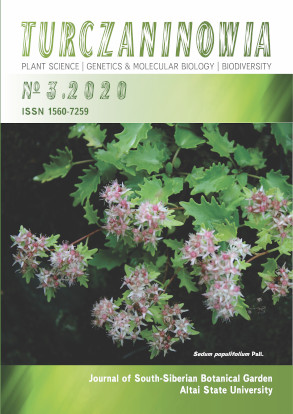Anatomical and morphological variability in Siberian species of the sections Multicaulia and Subacaulia of the genus Hedysarum (Fabaceae)
Abstract
The anatomical structure of the leaf blade of 6 Hedysarum species of the sections Multicaulia (H. chaiyr-akanicum Kurbatsky, H. gmelinii Ledeb., H. minussinense B. Fedtsch., H. sangilense Krasnob. et Timosch., H. setigerum Turcz. ex Fisch. et C. A. Mey., H. turczaninovii Peschkova) and Subacaulia (H. zundukii Peschkova) was studied under various growing conditions in Southern Siberia. The structural and quantitative changes in the leaf anatomical structure during the adaptation of plants to different conditions of water supply have been analyzed. Qualitative changes were expressed in the transition from the typically dorsi-ventral to the isolateral-palisade and isopalisade structure of the mesophyll. The gradual enhancement of xeromophic features in leaf structure also leads to a decrease in the leaf size and to the increase in the leaf blade thickness. This increases the number of palisade mesophyll layers and the number of stomata, the length of the palisade cells, the thickness of the epidermis, the size of the idioblasts. All these changes are considered as important biological adaptations of Hedysarum species of the sections Multicaulia and Subacaulia to the different growth conditions in Southern Siberia.
Downloads
Metrics
References
Бутник А. А. Ашурметов О. А., Нигманова Р. Н., Бегбаева Г. Ф. Экологическая анатомия пустынных растений Средней Азии. Т. 3. Травы. Ташкент: Фан, 2009. 155 с.
Ellis B., Daly D. C., Hickey L. J., Johnson K. R., Mitchell J. D., Wilf P., Wing S. L. 2009. Manual of leaf architecture. New York: Cornell University Press. 190 pp.
Гамалей Ю. В. Анатомия листа у растений пустыни Гоби // Бот. журн., 1984. Т. 69, № 5. С. 569–584.
Karnaukhova N. A. 2015. Ontogenesis and life forms of Hedysarum L. (Fabaceae) in South Siberia. Contemporary problems of ecology (Novosibirsk) 8(5): 614–623.
Карнаухова Н. А. Анатомическое строение листа Hedysarum gmelinii Ledeb. (Fabaceae) // Растительный мир Азиатской России, 2016. № 4(24). С. 3–9. DOI: 10.21782/RMAR1995-2449-2016-4(3-9)
Карнаухова Н. А., Дорогина О. В., Селютина И. Ю. Анатомическое строение листа видов секции Gamotion Basin. рода Hedysarum L. (Fabaceae) Южной Сибири // Turczaninowia, 2018. Т. 21, № 4. C. 150–160. DOI: 10.14258/turczaninowia.21.4.15
Krstic L., Merkulov Lj, Lukovic J., Boza P. 2008. Histological components of Trifolium L species related to digestive quality of forage. Euphytica 160: 277–286. DOI: 10.1007/s10681-007-9574-4
Липаева Л. И. О строении листьев пустынных растений Южного Прибалхашья // Бюл. МОИП. Отд. биол., 1952. Т. 57, № 5. С. 67–73.
Мокроносов А. Т., Багаутдинов Р. И., Бубнова Е. А., Кобелева И. В. Фотосинтетический метаболизм в палисадной и губчатой ткани листа // Физиология растений, 1973. Т. 20, вып. 6. С. 1191–1197.
Наумов Н. А., Козлов В. Е. Основы ботанической микротехники. М.: Сов. наука, 1954. 312 с.
Никифорова О. Д. Семейство Fabaceae Lindl. или Leguminosae Juss. // Конспект флоры Азиатской России: Сосудистые растения / Л. И. Малышев [и др.]; под ред. К. С. Байкова. Новосибирск: изд-во СО РАН, 2012. С. 229–261.
Паутов А. А. Структура листа в эволюции тополей // Тр. С.-Петерб. об-ва естествоиспытателей, 2002. Сер. 3. Т. 78. C. 1–164.
Пленник Р. Я. Морфологическая эволюция бобовых Юго-Восточного Алтая (на примере родовых комплексов Astragalus L. и Oxytropis DC.). Новосибирск: Наука, 1976. 216 с.
Пленник Р. Я., Попова Н. А. Особенности анатомического строения листа видов рода Hedysarum L. Южной Сибири в связи с вопросами их адаптации // Экология, 1990. № 5. С. 3–7.
Shields L. M. 1950. Leaf xeromorphy as related to physiological and structural influences. The Bot. Rev. 16(8): 399–447.
Василевская В. К. Анатомо-морфологические особенности растений холодных и жарких пустынь Средней Азии // Учен. зап. ЛГУ. Сер. биол. наук, 1940. Вып. 62, № 14. С. 48–158.
Василевская В. К. Формирование листа засухоустойчивых растений. Ашхабад: Изд-во АН ТССР, 1954. 183 с.
Василевская В. К., Бутник А. А. Типы анатомического строения листьев двудольных (к методике анатомического описания) // Бот. журн., 1981. Т. 66, № 7. С. 992–1001.
Zoric L., Merkulov L., Lukovic J., Boza P. 2012. Comparative analysis of qualitative anatomical characters of Trifolium L. (Fabaceae) and their taxonomic implications: preliminary results. Plant Syst Evol 298: 205–219. DOI: 10.1007/s00606-011-0538-8
Zoric L., Merkulov L., Lukovic J., Boza P., Polic D. 2009. Leaf epidermal characteristics of Trifolium L species from Serbia and Montenegro. Flora 204: 198–209.
Turczaninowia is a golden publisher, as we allow self-archiving, but most importantly we are fully transparent about your rights.
Authors may present and discuss their findings ahead of publication: at biological or scientific conferences, on preprint servers, in public databases, and in blogs, wikis, tweets, and other informal communication channels.
Turczaninowia allows authors to deposit manuscripts (currently under review or those for intended submission to Turczaninowia) in non-commercial, pre-print servers such as ArXiv.
Authors who publish with this journal agree to the following terms:
- Authors retain copyright and grant the journal right of first publication with the work simultaneously licensed under a Creative Commons Attribution License that allows others to share the work with an acknowledgement of the work's authorship and initial publication in this journal.
- Authors are able to enter into separate, additional contractual arrangements for the non-exclusive distribution of the journal's published version of the work (e.g., post it to an institutional repository or publish it in a book), with an acknowledgement of its initial publication in this journal.
- Authors are permitted and encouraged to post their work online (e.g., in institutional repositories or on their website) prior to and during the submission process, as it can lead to productive exchanges, as well as earlier and greater citation of published work (See The Effect of Open Access).





